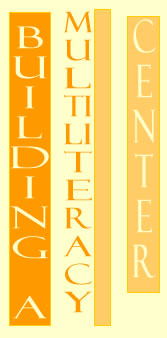

KHM: Instructors still wonder, though, how to balance the terms
of evaluation with multimodal compositions and where to put the weight
of the evaluation -- on the learning value gained from the student perspective,
on the value gained by the group or client involved, on the results the
work gives to the group, on an external list of criteria?
DS: Well, that's a great question, and I think you actually phrased the issue very well. I think that what George and I hope is that we achieve a balance in assessing the rhetorical effectiveness of all of these components -- words, images, sounds -- and try to account for the learning value of going through the process. I guess I do feel that the terms are slightly different, though maybe not fundamentally different, when you're talking about multimedia compositions as opposed to just writing in the narrow sense of the word. That is, even in my own writing classes, to a large extent, the student's grade is determined by the effectiveness of his or her writing.
In
a traditional writing class, to some degree, the grade that the student
receives in that class, and the grade that he or she receives on individual
assignments reflects the effectiveness of his or her writing. So I give
a student a B, and in my comments I explain why I thought a B was an appropriate
grade to give. And that's clearly an important part of assessment. But
also, I think a lot of writing instructors, including myself, try to take
into account in the assessment process the learning that's involved, the
fact that students went through the composing process, took it seriously,
participated in class, grappled with these issues, were engaged in the
course content. I think that most of us have, at least, a grade for classroom
participation.
I know that a lot of writing instructors will take it even further and
will sometimes have a component of the student's grade based solely on
the amount of prose that that student generated, operating under the principle
that you learn to write by doing it. And so, if the student has in fact
done the writing, the student deserves credit for that, even though the
writing itself is not as effective as it might be. I think that Peter
Elbow and other people have devised grading systems that have included
a component for just generating, just going through the process and doing
the work. And I think, to some extent, that carries over into multimodal
composition and, in some ways, is even more important. The students, even
if they didn't design great websites or perfect websites, they designed
websites, and they had to learn relevant things related to the rhetoric
of multimedia by going through that process. And they deserve a certain
amount of credit for that.
KHM: You had said earlier that, in doing this course again, you would have students do mock-up designs for each stage of the project. I think that's an interesting way of assessing students -- seeing how much they've learned about multimodal composing by reviewing their designs along the way.
DS: And we sort of did that with this class by having an early assignment in which each student created his or her own personal website and then reflected on it in writing. Each student then visited the Multiliteracy Center and received a response from a Multiliteracy Consultant.
KHM: How did that form of response work for giving students feedback?
DS:
It worked okay. Again, sometimes the students didn't complete their sites
until late in the course and some of this was the result of, at first,
wanting to do something pretty grandiose with the personal site, have
lots of movement and sounds and things on it that just weren't very realistic.
There's a learning curve there that we try to expedite by having the Multiliteracy
Consultants meet with the students and say, "Well, if you want digital
video, then here's what's involved with that process, and you have to
be realistic about the amount of time and the resources that you have
to devote to that in making that happen." Even with that, there are
some things you just have to learn the hard way. All of this -- composing
with technology, composing multimodal texts - is so new to the students,
to the instructor, to the curriculum that George and I felt like we needed
to allow for a pretty wide margin of error and a lot of flexibility. And
so what that meant is that students might get started on a personal website
and not finish it until the end of the term or may never finish it for
whatever reason. The learning sequence was then off because they didn't
necessarily go through the whole composing process before they started
work on the non-profit website. And so, they couldn't bring to that process
what they might have been able to if they had understood web design better
by going through it first on their own personal sites.
KHM:
The
main thing is that you built in assignments for students to practice designing
multimodal compositions even though some projects were not fully completed.
Although you attempted something new with this course, the web site products
that student groups made for the non-profit groups show an outstanding
effort that came from successful collaboration among student collaborators,
course instructors, and Multiliteracy Consultants. Thank you for sharing
with us your Multiliteracy Center program and what you've learned through
the process of supporting course instruction.
Top | Next
"The students, even if they didn't design great websites or perfect websites, they designed websites, and they had to learn relevant things related to the rhetoric of multimedia by going through that process. And they deserve a certain amount of credit for that."